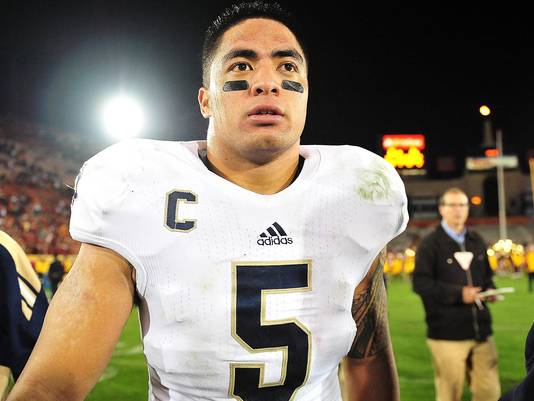Manti Te'o Is A Rube, Not A Hoax Coconspirator
"Proof of life" Twitter photos key to bizarre scam
NOTE: 1/19 update at bottom of story.
JANUARY 18--While Manti Te’o did himself no favors by hitting the mattresses in the wake of this week’s Deadspin report, there is compelling evidence--at least to TSG’s eyes--that the Notre Dame star was the victim of the remarkable hoax and not a coconspirator.
In a story packed with bizarre details and inexplicable behavior, it is key to focus on the actions last month of Te’o and Ronaiah Tuiasosopo, the 22-year-old California man who invented “Lennay Kekua,” the fictitious woman with whom Te’o, 21, maintained an online  romance/relationship. Until, of course, “Kekua” died last September of leukemia.
romance/relationship. Until, of course, “Kekua” died last September of leukemia.
As part of the “Kekua” hoax, Tuiasosopo established a Twitter account for the fake woman. The account, which has carried several different names since its inception in 2011, was most recently @LoveMSMK (until it was deleted earlier this month).
As Deadspin reported, the account included several Twitpics purporting to show "Kekua," an attractive brunette who appeared to be in her early 20s (one Te’o tweet indicated that she turned 22 last February 14, Valentine’s Day).
But the “Kekua” photos were actually images that had been taken from the Facebook and Instagram accounts of Diane O’Meara, a 23-year-old Los Angeles marketing executive. When interviewed by Deadspin, O’Meara identified Tuiasosopo as a former high school classmate whom she remembered fondly, but had not been in touch with since graduation.
Until last month.
Tuiasosopo, O’Meara recalled, contacted her on Facebook with a strange request. As Deadspin reported, Tuiasosopo claimed that his cousin “had been in a serious car accident, and he had seen her photos before and thought she was pretty. Would she be so kind as to take a picture of herself holding up a sign reading ‘MSMK,’ to put in a slideshow to support the cousin's recovery?”
Though puzzled by the request, O’Meara agreed and sent Tuiasosopo a photo showing herself holding a white piece of paper with the handwritten letters “MSMK” (the meaning of which O’Meara had no clue). As seen below, the photo of O’Meara with the sign was subsequently uploaded last month to the @LoveMSMK Twitter account’s profile. Te'o last September told Sports Illustrated that “Kekua”’s first name was actually Melelengei, so perhaps “MSMK” is a reference to her initials.
The addition of the photograph was not a random act on the part of Tuiasosopo, but rather a clear attempt by the hoax’s mastermind to establish “proof of life” for “Kekua,” who had purportedly died three months earlier.
So why would Tuiasosopo suddenly do this?
 According to Jack Swarbrick, Notre Dame’s athletic director, Te’o received a call on December 6 from a number that he “recognized as having been associated with Lennay Kekua.” The athlete answered the call and spoke with “a person whose voice sounded like the same person that he had talked to, who told him she was, in fact, not dead.”
According to Jack Swarbrick, Notre Dame’s athletic director, Te’o received a call on December 6 from a number that he “recognized as having been associated with Lennay Kekua.” The athlete answered the call and spoke with “a person whose voice sounded like the same person that he had talked to, who told him she was, in fact, not dead.”
During a press conference Wednesday evening, Swarbrick offered no further details of Te’o’s conversation (or conversations) with the back-from-the-dead “Kekua.”
However, the Honolulu Star-Advertiser today disclosed new details about the early-December contact between the Notre Dame star and “Kekua.” Citing a source close to the Te’o family, the newspaper reported that “Kekua” claimed to have staged her death to elude drug dealers, and sought to “re-engage a relationship with Te’o.”
[In an ESPN interview Friday night, Te’o himself said that “Kekua” claimed that she was being chased by drug dealers and had to disappear.]
But even the gullible All-American linebacker--whose bullshit detector desperately needed fresh batteries--was suspicious of the “Kekua” resurrection.
According to the Star-Advertiser, Te’o asked “Kekua” to “transmit a photo to him with a date stamp” (to presumably establish that she had not, in fact, been felled by leukemia). While “Kekua,” the paper reported, provided such a photo to Te’o, he was was not convinced and subsequently told his parents and Notre Dame officials that he had been hoaxed.
Though the photo provided to Te’o by “Kekua” was not described by the Star-Advertiser’s source, it seems obvious the image was the one extracted last month from O’Meara--clear out of the blue--by Tuiasosopo, her former high school friend who came calling with a ludicrous story about an injured cousin.
The new picture of O’Meara uploaded to the “Kekua” Twitter account was not a run-of-the-mill “selfie” that could have been snapped at any point during the past couple of years. Instead, she was specifically directed by Tuiasosopo to hold up the distinctive “MSMK” sign. While not  exactly a hostage-style image (with the subject holding up a newspaper to establish “proof of life”), the “MSMK” photo served a similar purpose for the scheming Tuiasosopo (seen at right).
exactly a hostage-style image (with the subject holding up a newspaper to establish “proof of life”), the “MSMK” photo served a similar purpose for the scheming Tuiasosopo (seen at right).
While the meaning of the four letters is unknown, a photo of “Kekua” holding the sign would have aided Tuiasosopo in trying to convince Te’o that she was alive.
First, the letters only surfaced on the “Kekua” Twitter account after her purported September 2012 death. The locked account had been renamed @LoveMSMK and appeared to become a memorial, of sorts, to “Kekua” (it carried the phrase “Sleep beautifully our sweet angel”). While “Kekua” was alive, the Twitter account had two names, @lovalovaloveYOU and @LennayKay, both of which were used to communicate with Te'o.
Additionally, the uploading of the “proof of life” photo to @LoveMSMK showed that “Kekua” maintained control of the Twitter account from which she once regularly sent messages to Te’o (and received tweets from the football player).
If Te’o was somehow involved in the hoax, there would have been no need for Tuiasosopo to scheme to obtain a fresh photo of O’Meara. Or to upload that December image to the “Kekua” Twitter account. He did it simply in a bid to further bamboozle the stunningly naïve Te’o.
Until she was contacted by Deadspin about a week ago, O’Meara was unaware that she was the social media face of “Kekua.” After learning that the “proof of life” photo she took at Tuiasosopo’s request was atop the @LoveMSMK Twitter account, O’Meara called to confront her former classmate.
The hoaxer, she recalled, “immediately began acting weird" and advised, "Don't worry about it." Shortly after the phone conversation ended, the photo of O’Meara holding the "MSMK" sign was deleted from the Twitter page of the dead girl who never lived.
1/19 UPDATE: ESPN this afternoon published lengthy excerpts from last night’s interview with Te’o, who told reporter Jeremy Schaap about the genesis of the “MSMK” photo. Te’o said that after “Kekua” resurfaced last month, he sought photographic proof that she was alive. He recalled telling “Kekua,” “I want you to hold a paper up with your initials, MSMK, which is her initials, the date and you throwing up the sign."
“Kekua” eventually complied with his demand, Te’o said, and forwarded him photos on December 21. Noting that the new pictures were proof of nothing, Te’o told Schapp, “All it shows is that girl that I knew her to be, with a paper with her initials on it, with the date, and with her throwing it up.”
The "proof of life" photos provided to Te’o by “Kekua” on December 21 are, of course, the same ones that O’Meara sent to Tuiasosopo. They show O’Meara holding up the “MSMK” sign and giving the Hawaiian “shaka” hand gesture. As seen above, both images were also uploaded late last month to the @LoveMSMK Twitter account, which has since been deleted.


